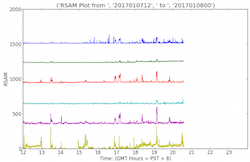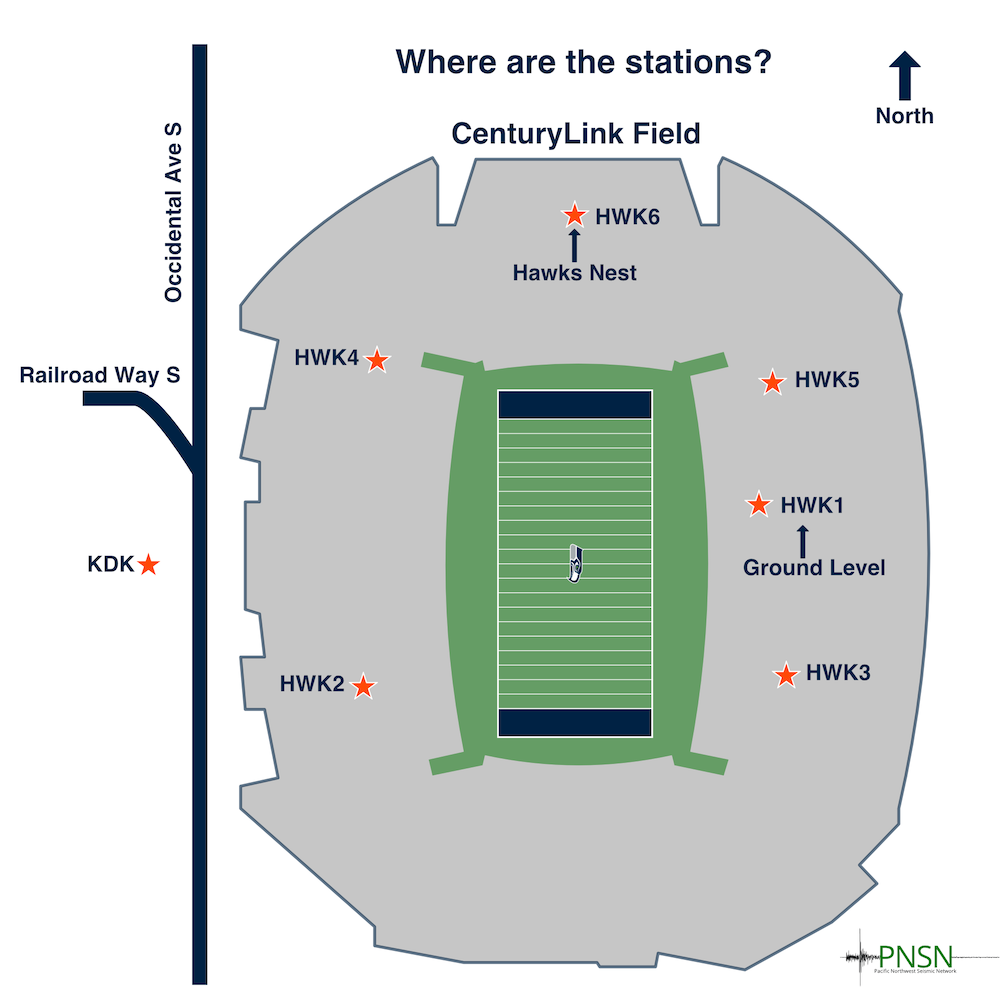Seattle Seahawks
The Pacific Northwest Seismic Network (PNSN), in cooperation with the Seattle Seahawks and CenturyLink Field management has been involved with seismically monitoring some NFC playoff games. Installing portable instrument in the stadium helps us to test our instruments, telemetry, analysis and can help us better understand the vibrations recorded during a football game.
These are experiments. Earthquakes are not predictable but Seahawk fan enthusiasm is. Scientifically we like to investigate how an excited crowd energizes the stadium structure to shake, and how that shaking propagates into the surrounding ground. Other more technical motivations are listed below. As a public service, we are providing public views of the motions we are recording in near real time.
Check out the blog for the Jan 7, 2017 play-off game against the Detroit Lions!
Where were the 2017 seismographs?
HWK1 is at field level under the east stands near the 35 yard line. At the ground level this station is the quietest and sees the least amount of seismic noise (squiggles) on the seismograph - or in this case the Hawk-o-Gram.
HWK2 and HWK4 are on the third level of the west stands. At the upper levels the seismic station will experience more noise and higher amplitudes (vertical displacement of the squiggles).
HWK3 and HWK5 are on the third level on east side.
KDK (the station that detected the 2011 #beastquake) is a permanent station inside a building just to the west of the stadium.
HWK6 is inside the Hawk's Nest about 200 feet above the ground level and will be more noisy, especially during the game!
Monitoring Products:
|
The current link has seismograph KDK and 4 PNSN stations in the greater Puget Sound region. The 2017 version featured six live seismographs (HWK1-HWK6) with ~ 1.5 second delay, a 10 minute window and playback features for notable plays with annotation. |
|
 |
Hawk-O-Grams
(2017 experiment)
~30 sec delay and hours duration |
 |
Fan-O-Meter (2017 experiment) ~10 sec delay and 10 minute duration |
 |
Realtime Seismic Amplitude Monitor (2017 experiment) seismic envelope every 10 seconds |
Attention seismologists: As of Jan 6, 2017 we have placed waveforms for the two week period around the Seahawks vs. Lions game at the IRIS DMC. You may obtain the data from HWK1, HWK2, HWK3, HWK4, HWK5 and KDK using the standard IRIS data access methods.
Check out our game blogs and learn how to interpret the displays with examples of signals seen on the seismograms.
- The "Beast Quake" of Jan. 8, 2011 indicated to us that Seattle Seahawk fans can really rock the world. We want to test just how much, how long and at what frequencies they do rock the world.
- PNSN staff needs practice and training in rapidly setting up telemetered seismic stations. Siting, installing, acquiring and analyzing data as quickly as possible following large earthquakes or seismic swarms at volcanoes are goals of PNSN operations. Practice improves performance.
- We want to improve our understanding of unusual ground vibrations in an urban setting. Along with the portable instruments in the stadium there are permanent seismographs in nearby areas for recording large earthquakes. We want to understand the variability in ground motions at different sites under background conditions (at night) and during other seismic inputs (vibrations caused by large machines such as trains and, of course, by crowds of people as well as earthquakes).
- We want to improve our understanding of the vibrational response of a large structure. A stadium will vibrate with characteristic modes based on its design. Engineers can learn about different design elements by studying the recorded vibrations under different input loads.
- We are interested in how the PNSN web site is used by the general public. This experiment should attract a different user group than those normally interested in seismic events. We hope to learn something about how to make the website more generally useful and interesting.
- We need to test the response of the PNSN website to a possible large number of requests. We anticipate that after a future large earthquake there will be lots of interest in our website, but until such an event we don't have a way to test how well it will technically perform. With enough publicity this "Seahawk fan" experiment may provide a good test.
Dr. John Vidale, Washington State seismologist and director of the Pacific Northwest Seismic Network, January 5th on 2017 install day.
- We have a new set of strong-motion seismographs that should be easier and faster to install than our older versions. We need to practice their installation, data acquisition and analysis in realistic conditions.
- We need to test a newly designed and constructed tool called "QuickShake" that can provide very near real-time (within 2-3 seconds) seismic waveforms to web browsers and to test how this will scale up to large number of users for use by the general public.
- We need to practice using social media for gathering questions and comments from the public to better produce useful information products.
- There are on-going nagging scientific questions not fully answered from last year's experiments, such as exactly what is causing the relatively low-frequency signals that are not related to on-field action and that we have tentatively identified and called, "Dance Quakes".
Seismologist technicians, David Bowen and Doug Gibbons installing one of our Titan SMA instruments.







